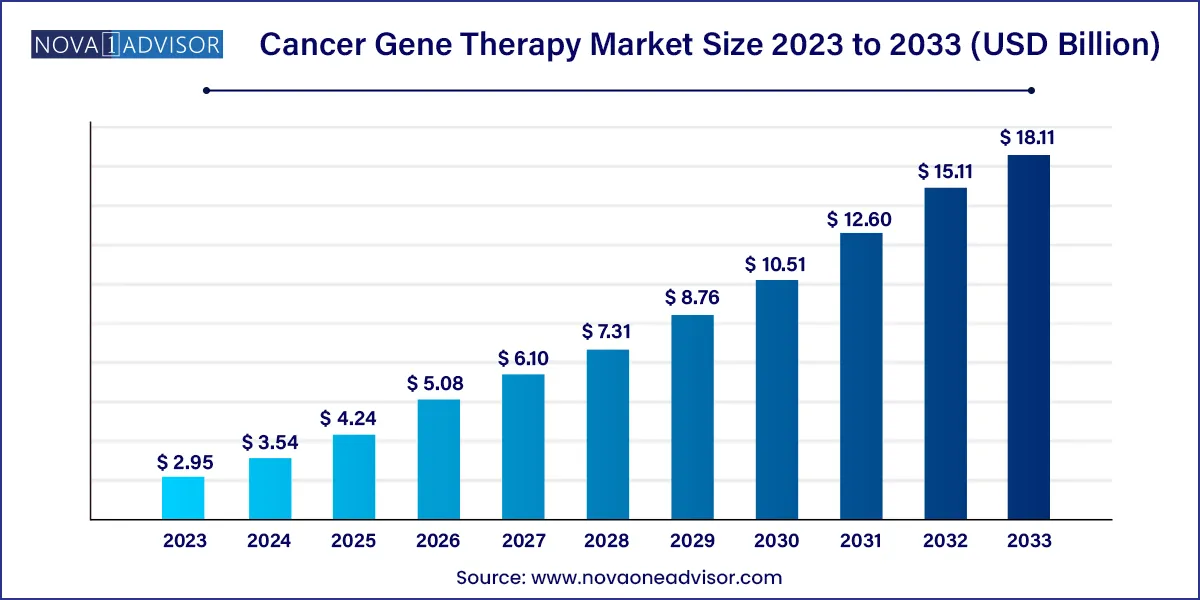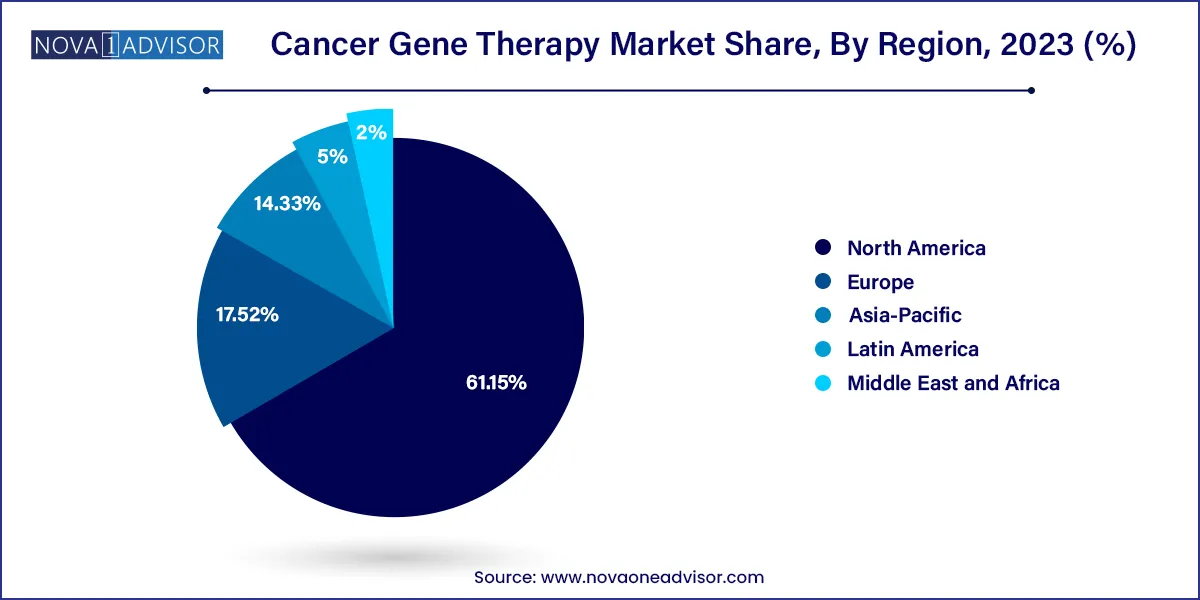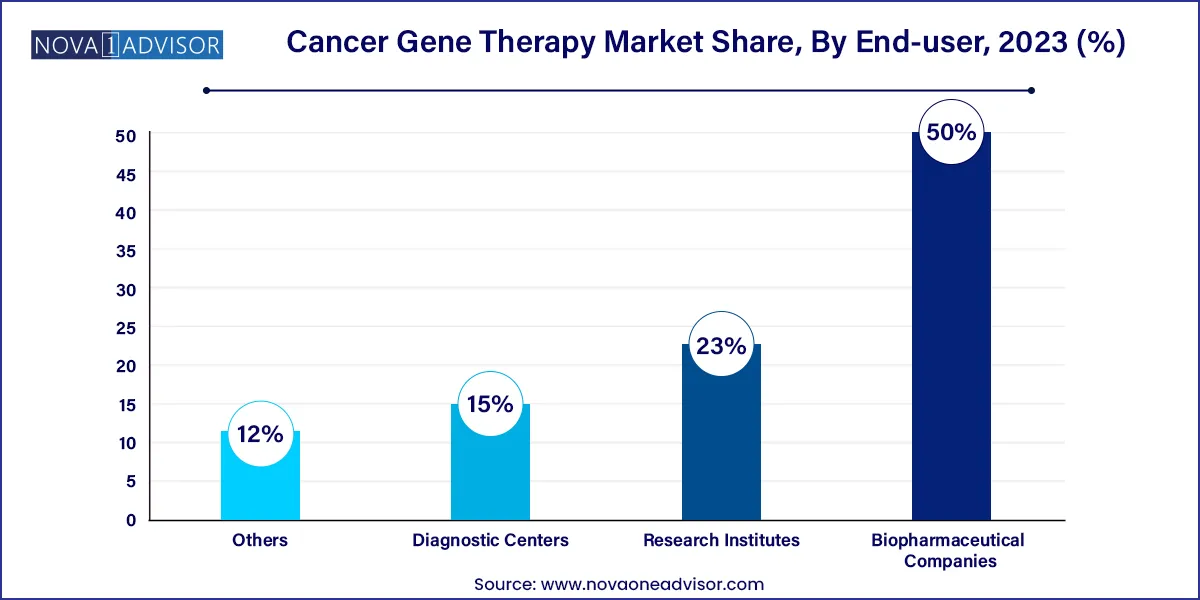The global cancer gene therapy market size was exhibited at USD 2.95 billion in 2023 and is projected to hit around USD 18.11 billion by 2033, growing at a CAGR of 19.9% during the forecast period 2024 to 2033.

Key Takeaways:
- North America accounted for the largest share of over 61.15% in 2023.
- Europe is estimated to be the fastest-growing region over the forecast period
- Gene induced immunotherapy dominated the market with a revenue share of over 41.9% in 2023.
- Oncolytic virotherapy is expected to grow at the fastest rate over the forecast period
- Biopharmaceutical companies led the market with a revenue share of over 50.0% in 2023.
- The biopharmaceutical companies segment is projected to grow at the fastest rate over the forecast period.
Cancer Gene Therapy Market Size in U.S. 2024 to 2033
The U.S. cancer gene therapy market size was valued at USD 1.25 billion in 2023 and is anticipated to reach around USD 7.94 billion by 2033, growing at a CAGR of 20.31% from 2024 to 2033.

North America dominates the global cancer gene therapy market, primarily due to robust R&D infrastructure, early adoption, favorable reimbursement frameworks, and the presence of leading biotech companies. The U.S. is home to most FDA-approved gene therapies and hosts the largest share of global clinical trials in this space. Regulatory agencies such as the FDA have also taken proactive steps by launching frameworks like the Breakthrough Therapy Designation and the Regenerative Medicine Advanced Therapy (RMAT) designation, speeding up the approval process.

The U.S. government’s Cancer Moonshot initiative and funding through the NIH have supported research into novel gene-based interventions. The country also benefits from advanced manufacturing facilities and public-private partnerships aimed at enhancing access and affordability. With academic centers, contract development and manufacturing organizations (CDMOs), and investors aligned toward innovation, North America is poised to remain the market leader.
Asia-Pacific is the fastest-growing region, driven by increasing cancer prevalence, rising healthcare expenditure, and government initiatives to support gene therapy innovation. China, in particular, has made remarkable strides with over 400 gene therapy trials currently ongoing and domestic approval of CAR-T therapies such as Yikaida (relma-cel) and Carteyva. Chinese companies like JW Therapeutics, Legend Biotech, and Fosun Pharma are actively developing homegrown therapies and expanding internationally.
Japan and South Korea also offer supportive regulatory environments. Japan’s PMDA has implemented expedited pathways for regenerative therapies under its Sakigake designation. Moreover, increasing collaborations between Western pharma and Asian biotech firms are improving knowledge exchange and technology transfer, fueling regional growth.
Market Overview
The Cancer Gene Therapy Market stands at the forefront of next-generation oncology treatment, representing one of the most innovative and transformative developments in modern medicine. Gene therapy for cancer involves modifying or manipulating the expression of genes to combat or prevent malignancies. Unlike conventional chemotherapy or radiotherapy that acts broadly on cancer cells (often affecting healthy cells), gene therapy offers targeted approaches with the potential for precision, fewer side effects, and durable responses.
With cancer incidence rising worldwide projected by WHO to reach 30 million new cases annually by 2040 there is an urgent demand for more personalized and effective therapeutic interventions. Gene therapy has emerged as a solution to various challenges associated with conventional therapies, including resistance, toxicity, and lack of specificity. By targeting genetic mutations, oncogenes, or defective immune responses, gene therapy can either kill cancer cells directly or enhance the body's immune system to do so.
The commercialization of the first gene therapies, such as Talimogene laherparepvec (T-VEC) for melanoma and CAR-T cell therapies like Kymriah and Yescarta, signaled a new era of cancer treatment. These approvals have accelerated research investments and led to a surge in clinical trials across multiple cancer types, including glioblastoma, pancreatic cancer, and hematological malignancies. With strong regulatory support, increasing biotech collaborations, and a burgeoning pipeline, the cancer gene therapy market is on the cusp of exponential growth.
Major Trends in the Market
-
Shift from Monogenic to Multigenic Targeting: Advanced gene editing tools are being used to simultaneously target multiple pathways to overcome tumor heterogeneity.
-
CRISPR/Cas9 Gene Editing Integration: Use of CRISPR for correcting oncogenic mutations or engineering immune cells is growing in clinical applications.
-
Rise in Oncolytic Virotherapy: Viruses engineered to selectively infect and kill tumor cells while stimulating the immune system are gaining clinical traction.
-
Increased Investment in Cell & Gene Therapy Manufacturing Facilities: Biopharma companies are expanding capacity to meet production needs for personalized therapies.
-
AI-Powered Genomic Analysis for Patient Selection: Artificial intelligence is being used to identify optimal candidates for gene therapy based on mutational signatures.
-
Expansion of Gene Therapy in Solid Tumors: Previously focused on blood cancers, gene therapy is now seeing promising results in hard-to-treat solid malignancies.
-
Strategic Collaborations and Licensing Deals: Big pharma is partnering with gene therapy startups to access novel delivery systems and viral vectors.
-
FDA Fast-Track and Breakthrough Designations: Regulatory bodies are offering accelerated approval paths to therapies addressing high unmet needs.
Cancer Gene Therapy Marke Report Scope
| Report Coverage |
Details |
| Market Size in 2024 |
USD 3.54 Billion |
| Market Size by 2033 |
USD 18.11 Billion |
| Growth Rate From 2024 to 2033 |
CAGR of 19.9% |
| Base Year |
2023 |
| Forecast Period |
2024-2033 |
| Segments Covered |
Therapy, End-use, Region |
| Market Analysis (Terms Used) |
Value (US$ Million/Billion) or (Volume/Units) |
| Regional Scope |
North America; Europe; Asia Pacific; Central and South America; the Middle East and Africa |
| Key Companies Profiled |
Abeona Therapeutics Inc.; Asklepios BioPharmaceutical Inc.; Altor Bioscience Inc.; Bluebird bio Inc.; BioCancell Inc.; Celgene Inc.; Elevate Bio Inc.; GlaxoSmithKline Inc.; Genelux Corporation; GenVec; Introgen Therapeutics Inc.; Merck KGaA; OncoGenex Pharmaceuticals Inc. |
Market Driver – Rising Prevalence of Cancer and Unmet Clinical Need
The growing global burden of cancer is the most significant driver for the cancer gene therapy market. According to the GLOBOCAN 2023 report, over 20 million new cancer cases and 10 million cancer-related deaths were reported worldwide. Despite advances in early detection and conventional treatments, mortality remains high in certain aggressive cancers like pancreatic, glioblastoma, and triple-negative breast cancer, where five-year survival rates remain below 10–20%.
Gene therapy offers a mechanism-based approach by targeting cancer at its genetic roots either through gene silencing, gene insertion, or immune modulation. For instance, therapies that introduce genes encoding tumor suppressor proteins or that repair defective p53 genes directly correct disease-causing mutations. Additionally, immunogenic gene therapies that stimulate a patient’s immune system offer long-term surveillance against recurrence. As these therapies demonstrate superior outcomes in refractory or relapsed settings, their integration into standard-of-care guidelines will become inevitable.
Market Restraint – High Development Costs and Complex Manufacturing
Despite its potential, one of the most pressing challenges for the cancer gene therapy market is the high cost and complexity of development and manufacturing. Developing gene therapies requires extensive preclinical testing, advanced vector design, and strict safety profiling due to risks like insertional mutagenesis or off-target effects. Clinical trials must be carefully designed to assess long-term efficacy and safety, especially given the potential for permanent genetic changes.
Manufacturing poses another hurdle. Personalized therapies like CAR-T cells must be produced individually using the patient’s cells, requiring advanced cleanroom infrastructure and rigorous quality control. These factors lead to per-patient treatment costs often exceeding $300,000–$500,000, making accessibility a concern even in developed healthcare systems. The need for cold chain logistics, limited skilled personnel, and regulatory oversight further complicate scalability and affordability.
Market Opportunity – Technological Innovations in Gene Delivery Systems
An exciting opportunity in the cancer gene therapy market lies in the development of innovative gene delivery systems. Efficient and targeted delivery of therapeutic genes remains one of the most crucial success factors for gene therapy. Traditional viral vectors (like adenovirus and lentivirus) offer high transduction efficiency but carry risks of immune reactions. Newer platforms, including non-viral vectors, nanoparticles, exosomes, and CRISPR-associated delivery technologies, promise enhanced safety and specificity.
For example, lipid nanoparticles (LNPs), which played a key role in mRNA vaccine delivery, are being adapted to deliver gene editing tools and tumor-targeting genetic material. Companies like Intellia Therapeutics and Beam Therapeutics are pioneering non-viral delivery methods to avoid immune complications and simplify large-scale production. As vector technology evolves, the reliability, reach, and efficacy of gene therapy will expand, unlocking treatment options for a broader array of cancers and patient populations.
By Therapy Insights
Oncolytic virotherapy dominated the market, owing to the clinical success and FDA approval of Imlygic (Talimogene laherparepvec), an oncolytic herpes simplex virus designed to treat unresectable melanoma. These therapies selectively replicate in tumor cells and induce immunogenic cell death, while also serving as a platform for in situ vaccination. Virotherapy represents a two-pronged attack—direct cytotoxicity and immune activation—offering promise in both primary and metastatic settings. Ongoing trials are expanding its use in glioblastoma, prostate, and colorectal cancers.
Gene-induced immunotherapy is the fastest-growing segment, particularly due to the rise of CAR-T cell therapies and T-cell receptor gene engineering. These therapies involve modifying a patient's immune cells to express tumor-specific antigens, enabling them to seek and destroy cancer cells. With the success of Kymriah, Yescarta, and newer CAR-Ts like Abecma for multiple myeloma, biotech firms are racing to develop allogeneic, off-the-shelf CAR-T platforms. As research shifts toward treating solid tumors, gene-induced immunotherapy is expected to see exponential growth and application across multiple cancer types.
By End-use Insights
Biopharmaceutical companies are the fastest-growing end-use segment, owing to their role in research, development, and commercialization. Startups and established players alike are building in-house gene editing and cell engineering platforms. Companies like Gilead Sciences, Novartis, and Bluebird Bio are expanding their pipelines beyond hematological cancers into areas such as ovarian, lung, and pancreatic cancers. This segment will continue to thrive as investment and M&A activity in the gene therapy space intensifies.

Hospitals dominate the market, given that gene therapies currently require complex administration and patient monitoring, often conducted in advanced oncology centers. Institutions like Memorial Sloan Kettering, MD Anderson Cancer Center, and Cleveland Clinic serve as hubs for both clinical trials and commercially approved therapies. Hospitals are also equipped to manage adverse events like cytokine release syndrome, common with some immunogene therapies.
Recent Developments:
-
March 2025 – Bluebird Bio received EMA approval for Zynteglo, a gene therapy for beta-thalassemia, expanding its pipeline in oncology through trials in AML and myelodysplastic syndromes.
-
February 2025 – Novartis launched a phase I/II trial of its CAR-T therapy targeting EGFR in glioblastoma, expanding its immunogene portfolio beyond hematologic cancers.
-
January 2025 – Krystal Biotech filed for FDA approval of its oncolytic HSV therapy, KB407, for head and neck squamous cell carcinoma.
-
December 2024 – Gilead’s Kite Pharma partnered with Oxford Biomedica to establish a new viral vector manufacturing facility to scale CAR-T production.
-
October 2024 – Intellia Therapeutics reported successful in vivo CRISPR editing in a patient with liver metastases from colorectal cancer, marking a world-first in cancer gene editing.
Some of the prominent players in the Cancer gene therapy market include:
- Abeona Therapeutics Inc.
- Asklepios BioPharmaceutical Inc.
- Altor Bioscience Inc.
- Bluebird bio Inc.
- BioCancell Inc.
- CelgeneInc.
- Elevate BioInc.
- GlaxoSmithKlineInc.
- Genelux Corporation
- GenVec
- Introgen TherapeuticsInc.
- MerckKGaA
- OncoGenex Pharmaceuticals Inc.
Segments Covered in the Report
This report forecasts revenue growth at global, regional, and country levels and provides an analysis of the latest industry trends in each of the sub-segments from 2023 to 2033. For this study, Nova one advisor, Inc. has segmented the global cancer gene therapy market.
Therapy
- Oncolytic Virotherapy
- Gene Induced Immunotherapy
- Gene Transfer
End-use
- Hospitals
- Research Institutes
- Biopharmaceutical Companies
- Diagnostic Centers
- Others
By Region
- North America
- Europe
- Asia-Pacific
- Latin America
- Middle East & Africa (MEA)




